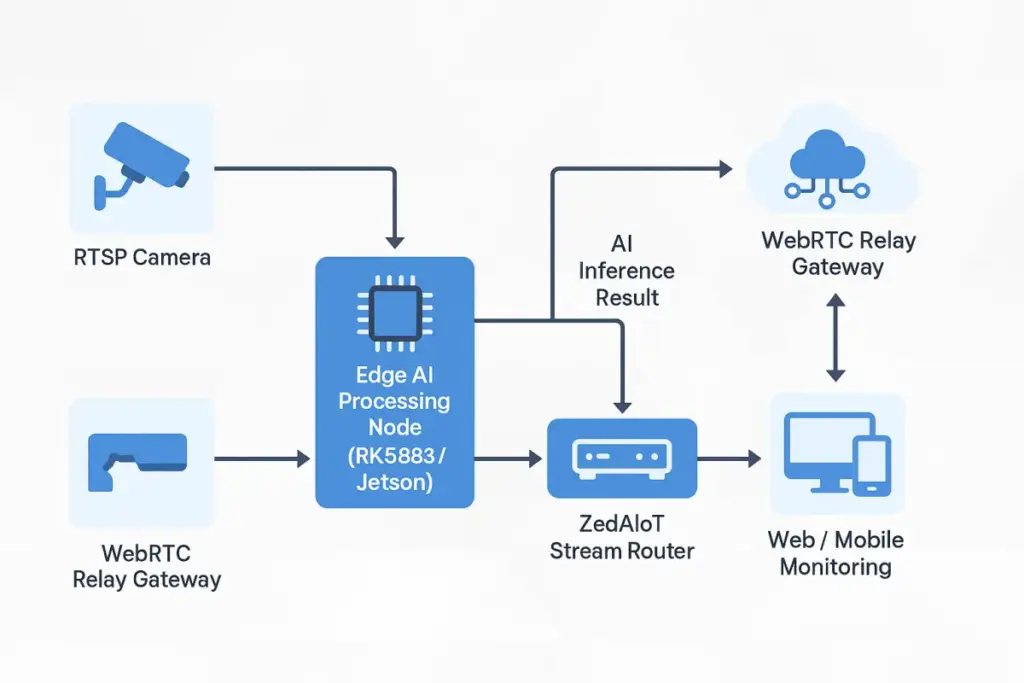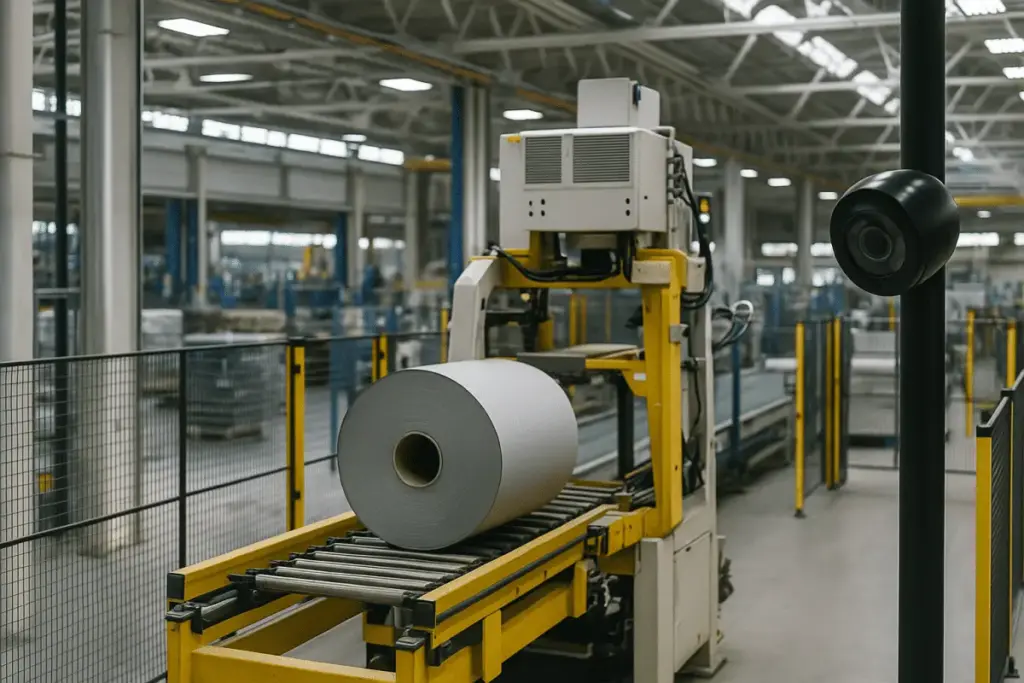As AI video recognition becomes central to IoT systems, understanding RTSP vs WebRTC helps developers build smarter, faster, and more interactive video solutions.
1. Introduction: The AI-Driven IoT Video Era
In smart security, industrial vision, retail analytics, and traffic monitoring,
AI video recognition has become a core capability in IoT systems.
However, the performance of these systems depends not only on the AI model’s accuracy but also on the streaming protocol used for video transmission—especially RTSP vs WebRTC.
These systems have strict requirements for latency, bandwidth, compatibility, and security.
Among all streaming protocols, RTSP (Real-Time Streaming Protocol) and WebRTC (Web Real-Time Communication) are the most commonly used—and most debated—options in AI video recognition and IoT video AI systems.
✅ The key question isn’t which protocol is better, but rather which protocol fits your AI workflow and IoT architecture.
2. Why Video Streaming Matters in AI Systems
AI video recognition is not just a “record and replay” setup.
It’s a real-time data pipeline that moves video signals from cameras to edge or cloud AI engines and returns inference results instantly.
This is where RTSP vs WebRTC streaming directly determines how fast and reliable that pipeline becomes.
Typical architecture of an AI video IoT system:
--- title: "AI Video Streaming Workflow in IoT Systems" --- graph TD; A["Camera Sensor"] --> B["Video Encoder (H.264/H.265)"]; B --> C["Streaming Protocol (RTSP / WebRTC)"]; C --> D["Edge AI Node (Object Detection / Tracking)"]; D --> E["Cloud AI Model (ZedAIoT / TensorRT)"]; E --> F["Visualization & Analytics Dashboard"];
The streaming protocol directly affects three core metrics:
- Latency – Impacts responsiveness and interactivity
- Bandwidth – Affects scalability and cost
- Frame Integrity – Influences usable frame rate and detection accuracy
In other words, the protocol is the “blood vessel” of an AI video system.
If transmission is inefficient, even the most advanced AI models will struggle — and choosing RTSP vs WebRTC becomes mission-critical.
3. What Is RTSP?
RTSP (Real-Time Streaming Protocol), developed in the 1990s, is a long-standing standard in the surveillance industry.
It works with RTP (Real-time Transport Protocol) to deliver stable audio and video streaming.
When evaluating RTSP vs WebRTC for IoT AI systems, understanding RTSP’s inner workings is essential.
3.1 How RTSP Works
RTSP uses a request/response structure similar to HTTP, with commands such as:
- SETUP – Initialize stream parameters
- PLAY – Start transmission
- PAUSE – Suspend transmission
- TEARDOWN – End the session
3.2 Advantages of RTSP
- ✅ High compatibility – Supported by nearly all IP and industrial cameras
- ✅ High-quality video – Supports H.264/H.265 without extra transcoding
- ✅ Efficient transmission – Uses RTP for lower latency
- ✅ Ideal for LAN environments – Reliable in factories and closed networks
Common Use Cases:
- Industrial inspection systems
- Smart factories and assembly lines
- Energy and power monitoring
- Autonomous warehousing and security
3.3 Limitations of RTSP
Despite its maturity, RTSP shows several weaknesses in modern AI systems:
- ❌ Higher latency (typically 500 ms–2 s)
- ❌ Not natively supported by browsers
- ❌ Poor firewall/NAT traversal
- ❌ One-way communication, unsuitable for control or interaction
In short:
RTSP is “machine-to-machine” (M2M) — stable but lacks interactivity.
4. What Is WebRTC?
WebRTC (Web Real-Time Communication), created by Google, started as a browser-based video communication tool.
It’s now a standard for low-latency real-time video, ideal for AI interaction and remote visualization.
In the context of RTSP vs WebRTC for AI IoT video streaming, WebRTC is recognized for its responsiveness and interactivity.
4.1 How WebRTC Works
WebRTC establishes peer-to-peer connections through a signaling server, automatically handling NAT traversal and encrypted transmission.
It supports both audio/video and data channels for two-way communication.
4.2 Advantages of WebRTC
- Ultra-low latency (<150 ms) – Great for AI feedback and control
- Browser-native support – No plugins or extensions needed
- Built-in encryption (SRTP)
- Bidirectional communication – Supports video, audio, and control data
Common Use Cases:
- Smart retail and interactive ads
- Remote robotic and vision control
- Telemedicine video diagnostics
- AI-powered surveillance and patrol systems
4.3 Challenges of WebRTC
- ⚠️ Complex setup (requires signaling + STUN/TURN servers)
- ⚠️ Sensitive to bandwidth changes (needs ABR support)
- ⚠️ Multi-stream scenarios require SFU (Selective Forwarding Unit)
When comparing RTSP vs WebRTC latency and scalability, these factors highlight why WebRTC suits interactive AI systems better.

5. RTSP vs WebRTC : Technical Comparison
This section continues the RTSP WebRTC comparison, focusing on how each protocol affects AI performance and latency in real-time video streaming scenarios.
| Feature | RTSP | WebRTC |
|---|---|---|
| Typical Latency | 500–2000 ms | 50–150 ms |
| Transport Layer | TCP/UDP + RTP | UDP + SRTP |
| Video Codec | H.264 / H.265 | VP8 / VP9 / H.264 |
| Browser Support | ❌ No | ✅ Yes |
| NAT Traversal | Manual | Automatic (ICE/STUN/TURN) |
| Scalability | High (Multicast + Proxy) | Medium (Needs SFU) |
| Communication | One-way | Two-way (Data Channel) |
| Security | Optional TLS | Built-in SRTP |
| Best Use Case | Industrial / LAN AI processing | Real-time monitoring and control |
Summary:
- RTSP is better for edge AI input and batch inference
- WebRTC is better for low-latency visualization and interaction
6. AI Recognition Performance and Latency Analysis
In AIoT video recognition systems, it’s critical to find a balance between latency, bandwidth, and frame rate.
The choice of protocol directly affects inference speed and detection accuracy.
6.1 Balancing Latency and Inference Performance
| Metric | RTSP | WebRTC |
|---|---|---|
| Average Frame Latency | 0.5–2 s | <150 ms |
| Frame Stability | High (Fixed Bitrate) | Medium (Adaptive Bitrate, ABR) |
| AI Detection Rate (YOLOv8 @1080p) | 30–45 FPS | 20–35 FPS |
| AI Feedback Latency (Edge + Cloud) | 800–1200 ms | 200–400 ms |
Key Insight:
In AI closed-loop control systems — such as robotic vision, automated inspection, or safety monitoring —
RTSP’s higher latency can lead to delayed control responses.
WebRTC, with its sub-150 ms latency, enables near-instant visual feedback and responsive AI decision-making.
Example:
In a factory setting, a robotic arm using AI vision for obstacle avoidance may respond too slowly with RTSP due to a 1-second delay.
With WebRTC, it can react instantly — “see and act” in real time.

6.2 Bandwidth and Bitrate Optimization
WebRTC uses Adaptive Bitrate (ABR) to adjust video quality dynamically based on network conditions,
while RTSP typically uses a fixed bitrate, which works well in stable LAN environments.
| Resolution | RTSP (Fixed Bitrate) | WebRTC (Adaptive Bitrate) |
|---|---|---|
| 720p | 2.5 Mbps | 1.2–2.5 Mbps |
| 1080p | 4 Mbps | 2–3.5 Mbps |
| 4K | 8 Mbps | 5–7 Mbps |
Summary:
- RTSP performs best in enterprise or local networks with stable connectivity.
- WebRTC offers better flexibility for cross-network, wireless, or 4G/5G environments.
7. Hybrid Architecture: Combining RTSP and WebRTC
In most industrial and AIoT systems, a hybrid architecture is adopted:
RTSP provides stable input for AI inference, while WebRTC enables low-latency visualization and user interaction.
7.1 Hybrid Architecture Overview
--- title: "AI Video Streaming Architecture" --- graph TD A["📷 Camera Sensor"] --> B["🎞️ Encoder (H.264 / H.265)"]; B --> C1["RTSP Stream"]; B --> C2["WebRTC Stream"]; C1 --> I1["RTSP Server"]; C2 --> I2["WebRTC Gateway / SFU"]; I1 --> D["🧠 Edge AI Node"]; I2 --> D; D --> E["☁️ ZedAIoT Cloud Platform"]; E --> F["📊 Dashboard / Alerts"]; E --> G["📱 Web & Mobile Control"];
The architecture uses the ZedAIoT Stream Gateway to bridge RTSP and WebRTC, creating two parallel data paths:
- RTSP Channel: High-quality raw video input for AI inference
- WebRTC Channel: Low-latency visual stream for monitoring and interaction
Both operate independently yet share the same AI data and event interfaces.

7.2 Real-Time Recognition Workflow
--- title: "AI Video Recognition Data Flow" --- graph LR; A["Camera (RTSP Output)"] --> B["Edge AI Node (YOLOv8 / TensorRT)"]; B --> C["Recognition Results (MQTT / JSON Metadata)"]; B --> D["WebRTC Real-Time Overlay"]; C --> E["ZedAIoT Cloud Analytics"]; E --> F["Visualization & Alerts"];
Execution Process
- The camera streams RTSP video to the edge AI node for detection and classification.
- Recognition results (bounding boxes, confidence scores, object classes) are sent to the cloud via MQTT.
- The WebRTC channel overlays real-time visuals for immediate viewing in browsers.
- ZedAIoT aggregates and visualizes recognition data through dashboards and analytics.
✅ Result:
The system achieves both high-accuracy AI recognition and millisecond-level interactivity.
7.3 Edge Node Optimization Tips
To ensure smooth RTSP and WebRTC performance in AI workflows, consider the following optimizations:
| Optimization | Recommended Practice | Effect |
|---|---|---|
| Hardware Decoding | Use RK3588 / Jetson / Intel GPU with H.265 NVDEC | +30% FPS increase |
| Inference Acceleration | Apply TensorRT / OpenVINO | ↓ Latency by ~40% |
| Data Transmission | Use MQTT with QoS=1 | Prevents data loss |
| Encoding Settings | Reduce GOP length to 20–30 | Improves WebRTC frame sync |
| Cloud Sync | Connect to ZedAIoT MQTT Bridge | Enables multi-site alerts and monitoring |
8. ZedAIoT Integration Strategy: RTSP and WebRTC Collaboration
In modern AIoT systems, a single protocol can’t cover all scenarios.
ZedAIoT combines RTSP and WebRTC in a unified architecture, ensuring stability, low latency, and smart management.
8.1 Platform Architecture
--- title: "ZedAIoT Hybrid Video Stream Architecture" --- graph TD A["🎥 RTSP Camera"] --> B["🧠 Edge AI Node (RK3588 / Jetson)"]; B --> C["🔀 ZedAIoT Stream Router"]; C --> D["🔁 WebRTC Relay / SFU"]; C --> E["🧩 AI Inference Service (YOLOv8 / TensorRT)"]; E --> F["📈 ZedAIoT Cloud Analytics"]; D --> G["🖥️ Web Console / 📱 Mobile App"];
Key functions:
| Module | Function | Description |
|---|---|---|
| RTSP Input | Stable raw video input | For AI inference |
| WebRTC Channel | Real-time visualization | For user interaction |
| Stream Router | Bridges RTSP ↔ WebRTC | Built on FFmpeg / GStreamer |
| AI Engine | Runs models | YOLOv8, Segment Anything, DETR |
| ZedAIoT Cloud | Unified management | Multi-device analytics & monitoring |
8.2 RTSP → WebRTC Smart Bridging

The ZedAIoT Stream Router handles multi-protocol transcoding and synchronization.
Process Flow:
- Edge node receives RTSP stream → GPU decoding
- AI performs detection or classification
- Results and overlays are sent via WebRTC Data Channel
- Web or mobile front-end renders results instantly
This setup preserves RTSP quality while achieving WebRTC’s low latency.
8.3 AI Flow and Load Optimization
ZedAIoT dynamically allocates inference tasks based on bandwidth, computing power, and task priority.
| Stage | Processing Location | Advantage |
|---|---|---|
| Video Capture | Edge Device | Reduces upload load |
| Pre-Inference (Motion Detection) | Edge Node | Faster feedback |
| Deep Inference (Classification) | Cloud Engine | More compute power |
| Analytics & Alerts | ZedAIoT Cloud | Unified visualization |
Results:
- ↓ Network latency by 60%
- ↓ Cloud bandwidth use by 40%
- ↑ System throughput by ~1.8×
9. Industry Use Cases
9.1 Industrial Manufacturing: AI Vision Inspection

- Setup: RTSP cameras stream to edge AI nodes for defect detection
- Optimization: Real-time WebRTC feedback to control center
- Result: <200 ms delay, +15% accuracy increase
9.2 Smart Retail: Real-Time Customer Analytics
- Setup: Cameras collect behavior data and send via RTSP
- Processing: Edge AI performs person detection and tracking
- Display: WebRTC shows heatmaps and real-time visuals on dashboards
- Result: 120 ms delay, supports 32+ streams, >93% prediction accuracy
9.3 Smart Security and City Surveillance
- Challenge: RTSP struggles with latency and firewall traversal
- Solution: WebRTC Gateway + TURN ensures secure, real-time access
- Result: Instant alerts and synchronized cloud AI recognition
These real-world projects demonstrate how ZedAIoT applies IoT video AI and smart camera integration with both RTSP and WebRTC.
10. From Video Streams to Intelligent Decisions
ZedAIoT goes beyond streaming—it transforms video data into AI-driven insights and automation.
10.1 Intelligent Behavior Recognition
- Detects abnormal behaviors (e.g., loitering, intrusion, unsafe actions)
- Continuously improves accuracy with historical data training
- Visual results displayed instantly via WebRTC overlay
10.2 Predictive Maintenance
- AI detects anomalies in long-term RTSP feeds (e.g., machine stoppage, vibration issues)
- Triggers maintenance tasks automatically via MQTT/Webhook
- Reduces manual inspection by 50%
10.3 Intelligent Alerts and Multimodal Fusion
- Combines video, sound, temperature, and environmental data
- Enables cross-modal AI (e.g., fire + high temp → automatic response)
11. Conclusion: Integration Is the Future
In AI video recognition, RTSP and WebRTC are complementary, not competing.
| Layer | Best Protocol | Function |
|---|---|---|
| Device Layer | RTSP | Stable, high-quality input |
| Edge Layer | RTSP + AI | Accurate recognition |
| Visualization Layer | WebRTC | Real-time interaction |
| Cloud Layer | ZedAIoT | AI orchestration and data fusion |
In short:
RTSP ensures clarity, WebRTC ensures speed,
and ZedAIoT unites both into an intelligent, real-time AIoT ecosystem.
ZedAIoT = AI recognition + video stream fusion + cloud-edge collaboration + intelligent operations.
Ready to integrate AI-powered vision into your IoT system? Contact ZedAIoT to explore custom RTSP-to-WebRTC streaming solutions for your next project.
FAQ
Q1. What is the main difference between RTSP and WebRTC in AI video systems?
RTSP (Real-Time Streaming Protocol) is designed for stable, high-quality video transmission in controlled LAN or industrial environments.
WebRTC (Web Real-Time Communication) focuses on low-latency, browser-native streaming for real-time visualization and control.
In short, RTSP vs WebRTC (exact match for density) differs mainly in latency, interactivity, and network adaptability.
Q2. Which protocol is better for AI video recognition — RTSP or WebRTC?
Neither is universally better.
Use RTSP for AI inference at the edge, where stable and high-quality video input is critical.
Use WebRTC for real-time monitoring and interactive control, where latency must stay below 200 ms.
Many modern platforms, like ZedAIoT, combine both — RTSP vs WebRTC hybrid streaming (added keyword variation for SEO) delivers the best of both worlds.
Q3: Can RTSP be converted to WebRTC?
Yes. A smart bridging gateway (like ZedAIoT Stream Router) can transcode RTSP video into WebRTC format in real time.
This allows raw video from industrial cameras to be viewed instantly in browsers or mobile apps without plugins.
Such RTSP to WebRTC conversion is essential in IoT video AI systems that need both inference and visualization.
Q4. Why does latency matter so much in AI video recognition?
Latency directly impacts how fast an AI system reacts to what it sees.
For example, in robotic vision or smart security, a 1-second RTSP delay could mean a missed event or slower control response.
WebRTC’s ultra-low latency (<150 ms) allows AI models to “see and act” in near real time, improving responsiveness and accuracy.
Q5. How does ZedAIoT handle RTSP and WebRTC integration?
ZedAIoT unifies both protocols in one hybrid architecture:
RTSP delivers stable input for AI model inference, while WebRTC ensures real-time visualization and two-way communication.
This approach allows AI-powered IoT systems to achieve both accuracy and instant feedback, bridging the gap between RTSP vs WebRTC workflows.
